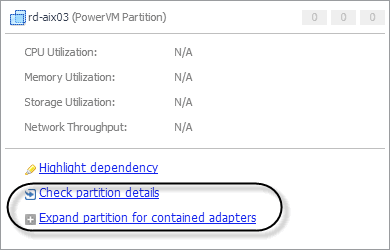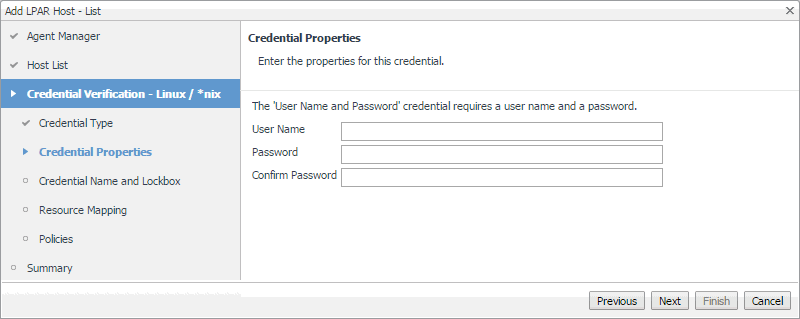Drilling down on physical and virtual network adapters
The Network - Virtual Ethernet Adapters Detail and Network - Physical Ethernet Adapters Detail views provide information about physical and virtual network adapters associated with the selected PowerVM® VIOS. Use it to find out if the adapters exhibits low throughput, high levels of dropped packets or errors, to maintain the stability of your system and ensure optimum network throughput levels.
To navigate to these views, in the Selected Service PowerVM view, select a PowerVM VIOS, and click Explore. Open the Network tab, and then open the Summary tab. In the Virtual Ethernet Adapters Summary area, click View VEA Details, to see the Network - Virtual Ethernet Adapters Detail view. To access the Network - Physical Ethernet Adapters Detail view, in the Physical Ethernet Adapters Summary area, click View PEA Details.
Investigating object dependencies
To navigate to dependency views, in the Selected Service PowerVM view, select a PowerVM® partition, managed server, or PowerVM VIOS, and click Explore. Open the Memory tab (managed servers only), Storage tab, or Network tab, and then open the Dependencies tab.
|
1 |
On the Infrastructure Environment dashboard, on the Monitoring tab, select a managed server, partition, or VIOS, and click Explore. |
|
2 |
On the Detail view appearing in the display area, open the Storage or Network tab, and click Dependency. |
Every object appearing in the map includes an indicator of its health.
Dependencies between the objects in a map are illustrated with single-directional arrows.
This causes all of the related objects and dependencies to appear highlighted in the map.
In addition to Highlight dependency, some object types offer other options when selected. For example, when you click a partition, you can click Check partition details to drill down on the partition, or Expand partition or Collapse partition for contained adapters to show or hide the network adapters the selected partition uses.
Reviewing frequently asked questions
You can find the available questions on the FAQts tab of the Infrastructure Environment dashboard.
On this tab, the Categories pane contains several question groups. Selecting a category shows the questions belonging to that category in the Questions pane. From there, clicking a question shows the answer on the right.
Monitoring a partition or VIOS with Foglight for Infrastructure
If you want to monitor a VIOS or a partition with Foglight for Infrastructure, you can quickly create a Host agent. Foglight for PowerVM allows you to monitor the health of the system infrastructure associated with a monitored VIOS or a partition. For complete information about host agents, see Using Foglight for Infrastructure agents.
|
1 |
|
a |
|
b |
|
c |
In the Which VIOS are not monitored by Host Agent pane, select a VIOS, and click Add VIOS Hosts Monitoring. |
|
a |
|
b |
|
c |
In the Which partitions are not monitored by Host Agent pane, select a partition, and click Add Partition Hosts Monitoring. |
|
3 |
In the Add LPAR Host - List wizard, on the Agent Manager page, select the Agent Manager that you want to associate with the Host agent you are about to create. |
|
a |
Click Agent Manager and select the Agent Manager host that you want to use to associate with the Host agent. The list includes only the Foglight Agent Managers to which the Foglight for Infrastructure agent package is already deployed. |
|
b |
Ensure that the Virtual / Guest check box is cleared. |
|
c |
Click Next. |
|
4 |
In the Add LPAR Host - List wizard, on the Host List page, review the list of VIOS or partition instances that you selected for monitoring. |
|
a |
By default, the VIOS or partition name is used as a host name. If you want to display one or more of these components under a different name in the browser interface and reports, click the Host Name Override column, and type a new name when prompted. |
|
b |
Click Next. |
|
5 |
On the Credentials Verification page, select one of the following options: |
|
• |
Do not configure a credential: Select this option if you want to configure the credential for this component at a later time. Click Next and continue to Step 8. |
|
• |
Add host(s) to a new credential: Select this option if you want to create a new credential for this component. This option is suitable if none of the existing credentials have the connection details needed to access the new host. Click Next and continue to Step 6. |
|
• |
Add host(s) to an existing credential: Select this option if you want the Host agent to use an existing credential to access this component. This option is suitable if an existing credential has the security data needed to access this component (such as user name and password), but you need to edit its resource mappings to include this component. Click Next and continue to Step 7. |
|
• |
For complete information about Foglight credentials, see the Administration and Configuration Help. |
|
a |
On the Credential Type page that appears, select the desired credential type. |
|
b |
|
c |
On the Credential Properties page, provide the required information. The level of required data depends on the selected credential type. For example, a User Name and Password credential needs a user name and a password, while a Challenge Response credential requires a user name along with a question/response pair. |
|
d |
|
e |
On the Credential Name and Lockbox page, provide a name to identify the credential, and select a lockbox in which you want to keep the credential. A lockbox can be used to group credentials for access and/or security. The default System lockbox is sufficient for smaller installations. |
|
f |
|
g |
On the Resource Mapping page, ensure that the VIOS or partition components that you want to associate with this credential are selected. |
|
h |
|
i |
Optional—On the Policies page, define one or more policies for this credential. A policy defines the number of times a credential can be used, the number of allowed authentication failures, the time range during which the credential is valid, or the length of time the credential data can be cached on the client. For example, you can specify the number of times the credential can be used, or the time period during which it can be used. For complete information about the available credential policies, see the Administration and Configuration Help. |
|
a |
On the Credential page that appears, select an existing credential that you want the Host agent to use to access this component. |
|
b |
|
c |
On the Resource Mapping page, ensure that the VIOS or partition components that you want to associate with this credential are selected. |
|
8 |
On the Summary page that appears, review the information about the monitored component, selected Agent Manager, and the credential. |
|
9 |
Click Finish. |

























